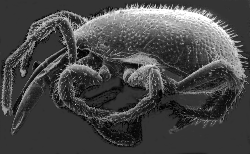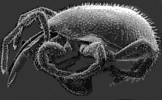Parasitiformes
Holothyrans, ticks and mesostigmatic mites
David Evans Walter


This tree diagram shows the relationships between several groups of organisms.
The root of the current tree connects the organisms featured in this tree to their containing group and the rest of the Tree of Life. The basal branching point in the tree represents the ancestor of the other groups in the tree. This ancestor diversified over time into several descendent subgroups, which are represented as internal nodes and terminal taxa to the right.

You can click on the root to travel down the Tree of Life all the way to the root of all Life, and you can click on the names of descendent subgroups to travel up the Tree of Life all the way to individual species.
For more information on ToL tree formatting, please see Interpreting the Tree or Classification. To learn more about phylogenetic trees, please visit our Phylogenetic Biology pages.
close boxIntroduction
The Parasitiformes is one of the three major lineages of chelicerate arthropods that are called mites. Ticks are among the most economically important parasitiform mites, but numerous Mesostigmata, especially in the Dermanyssoidea are also debilitating parasites of mammals, birds, and reptiles. The phytoseiid mites used in biological control belong to the Mesostigmata, as do numerous species of predators that inhabit soil-litter systems. Currently, both the Ixodida (ticks) and Holothyrida consist of three families; the Mesostigmata contains approximately 70 family-level taxa.
Characteristics
Parasitiform mites have free coxae, a ventral anal opening covered by a pair of plates, corniculli on the hypostome (lost in ticks), a sclerotised ring surrounding the gnathosoma (capitulum), and usually a biflagellate tritosternum (lost in ticks, many holothyrids, and some parasitic Mesostigmata).
Discussion of Phylogenetic Relationships
The hypothesis by Lehtinen (1991) supports a sistergroup relationship between Holothyrida and Ixodida; however, other acarologists have suggested that ticks and Mesostigmata are sistergroups. Phylogenetic analyses addressing the proper placement of ticks are underway in Queensland and Ohio.
References
Lehtinen, P.T. 1991. Phylogeny and zoogeography of the Holothyrida. In: Dusabek, F. and Bukva, V. (eds.) Modern Acarology, Volume 2. SPB Academic Publishers, The Hague, pp. 101-113.
Title Illustrations

SEM of Allothyrus sp. from Queensland (D.E. Walter)
| Scientific Name | Allothyrus sp. |
|---|---|
| Location | Queensland |
| Image Use |
 This media file is licensed under the Creative Commons Attribution-NonCommercial License - Version 3.0. This media file is licensed under the Creative Commons Attribution-NonCommercial License - Version 3.0.
|
| Copyright |
© 1996
David Evans Walter

|
About This Page
David Evans Walter

University of Alberta, Edmonton, Alberta, Canada
Correspondence regarding this page should be directed to David Evans Walter at
dew@ualberta.ca
Page copyright © 1996 David Evans Walter
 Page: Tree of Life
Parasitiformes. Holothyrans, ticks and mesostigmatic mites.
Authored by
David Evans Walter.
The TEXT of this page is licensed under the
Creative Commons Attribution-NonCommercial License - Version 3.0. Note that images and other media
featured on this page are each governed by their own license, and they may or may not be available
for reuse. Click on an image or a media link to access the media data window, which provides the
relevant licensing information. For the general terms and conditions of ToL material reuse and
redistribution, please see the Tree of Life Copyright
Policies.
Page: Tree of Life
Parasitiformes. Holothyrans, ticks and mesostigmatic mites.
Authored by
David Evans Walter.
The TEXT of this page is licensed under the
Creative Commons Attribution-NonCommercial License - Version 3.0. Note that images and other media
featured on this page are each governed by their own license, and they may or may not be available
for reuse. Click on an image or a media link to access the media data window, which provides the
relevant licensing information. For the general terms and conditions of ToL material reuse and
redistribution, please see the Tree of Life Copyright
Policies.
- First online 13 December 1996
- Content changed 13 December 1996
Citing this page:
Walter, David Evans. 1996. Parasitiformes. Holothyrans, ticks and mesostigmatic mites. Version 13 December 1996 (under construction). http://tolweb.org/Parasitiformes/2566/1996.12.13 in The Tree of Life Web Project, http://tolweb.org/







 Go to quick links
Go to quick search
Go to navigation for this section of the ToL site
Go to detailed links for the ToL site
Go to quick links
Go to quick search
Go to navigation for this section of the ToL site
Go to detailed links for the ToL site